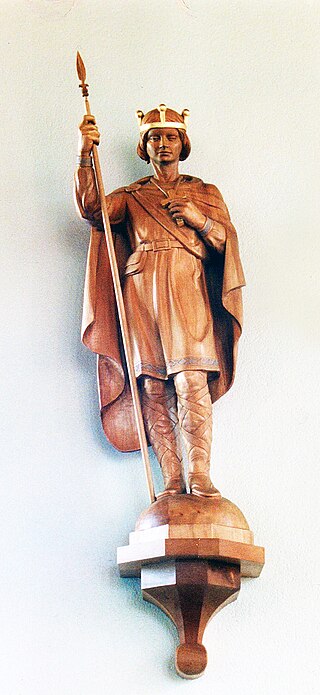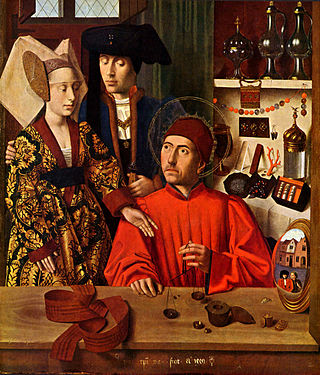Related Research Articles

Pope Callixtus I, also called Callistus I, was the bishop of Rome from c. 218 to his death c. 222 or 223. He lived during the reigns of the Roman emperors Elagabalus and Alexander Severus. Eusebius and the Liberian catalogue list his episcopate as having lasted five years (217–222). In 217, when Callixtus followed Zephyrinus as Bishop of Rome, he started to admit into the Church converts from sects or schisms. He was martyred for his Christian faith and is venerated as a saint by the Catholic Church.

April 5 — Eastern Orthodox liturgical calendar — April 7

Saint Kenelm was an Anglo-Saxon saint, venerated throughout medieval England, and mentioned in the Canterbury Tales. William of Malmesbury, writing in the 12th century, recounted that "there was no place in England to which more pilgrims travelled than to Winchcombe on Kenelm's feast day".

April 16 - Eastern Orthodox liturgical calendar - April 18

April 25 - Eastern Orthodox liturgical calendar - April 27

July 16 - Eastern Orthodox Church calendar - July 18

July 20 - Eastern Orthodox Church calendar - July 22

February 3 - Eastern Orthodox liturgical calendar - February 5

The Diocese of Troyes is a Latin Church ecclesiastical territory or diocese of the Catholic Church in Troyes, France. The diocese now comprises the département of Aube. Erected in the 4th century, the diocese is currently a suffragan diocese in the ecclesiastical province of the metropolitan Archdiocese of Reims. It was re-established in 1802 as a suffragan of the Archbishopric of Paris, when it comprised the départements of Aube and Yonne and its bishop had the titles of Troyes, Auxerre, and Châlons-sur-Marne. In 1822 the See of Châlons was created and the Bishop of Troyes lost that title. When Sens was made an archdiocese, the episcopal title of Auxerre went to it and Troyes lost also the département of Yonne, which became the Archdiocese of Sens. The Diocese of Troyes covers, besides the ancient diocesan limits, 116 parishes of the ancient Diocese of Langres and 20 belonging to the ancient diocese of Sens. On 8 December 2002, the Diocese of Troyes was returned to its ancient metropolitan, the Archbishop of Reims. As of 2014, there was one priest for every 2,710 Catholics.

Landrada of Austrasia was a German saint and ascetic. She co-founded Munsterbilsen Abbey, which was dedicated to the Virgin Mary. Landrada's feast day is 8 July. She is the patron saint of Munsterbilsen and Ghent.

Godeberta was a saint and abbess. She was born of "pious parents" in Amiens, France, north of Paris. Her parents were nobles attached to the king's court, so she was carefully educated. When Godeberta was old enough, her father took her to the king's court to obtain permission to "marry her to someone of suitable rank and fortune". Saint Eligius, who was present at court, was able to see that she wanted to "dedicate her virginity to God", and took off his episcopal ring and placed it on her finger in the presence of the king, pronouncing her a nun. Godeberta refused offers of marriage by her noble suitors, and the king, impressed with her zeal and conduct, endowed Godeberta with a small palace in nearby Noyon, north of France, with a chapel dedicated to Saint George. She turned her home into a monastery, where she was abbess for 12 young women. She chose Eligius as her spiritual guide.

Saint Mellonius (229-314) was an early 4th-century Bishop of Rotomagus in the Roman province of Secunda Provincia Lugdunensis. He is known only from a 17th-century 'Life' of little historical value, meaning the historicity of his existence is uncertain.

Hermione of Ephesus is a 2nd-century saint and martyr venerated by the Eastern Orthodox and Roman Catholic Churches. She was well known as a "great healer" and founded the first Christian hospital in Ephesus.
Glodesind (572−608) was a saint, nun, abbess, and founder of a convent in Metz, France, during the time of King Childebert II (575−596) of Austrasia. She was a member of the Carolingian nobility. When she was 11 or 12 years old, she married a young nobleman, who was arrested by the French government shortly after their wedding and executed a year later. Instead of remarrying as her family wanted, she fled to Metz and took refuge at the Church of St. Stephen. Her family gave up forcing her to marry, and she became a nun and later, the abbess of a convent that was built by her parents. She was abbess for six years until her death in 608 at the age of 30. Her feast day is 8 July.

March 15 - Eastern Orthodox liturgical calendar - March 17

Saint Avoye of Sicily, also known as Saint Auré or Saint Ewe, was a Christian martyr from the 3rd century, who was originally from Sicily, Italy. She died in Boulogne-sur-Mer, France around 234, according to tradition. She is recognized as a saint in the Catholic Church.
Apollinaris Syncletica was a saint and hermit of the 5th century, venerated in the Roman Catholic and Eastern Orthodox churches. Her story is most likely apocryphal and "turns on the familiar theme of a girl putting on male attire and living for many years undiscovered".
Apronia of Toul, also called Evronie of Troyes, was a nun and saint of the 6th century. She was born at Tranquille, a village in Trier, Germany. Her brother was Saint Aprus of Toul, a bishop in Toul in northeastern France, from whom she received the veil. Hagiographer Sabine Baring-Gould said of Apronia: "Drawn by her love of Christ to a religious life, she led on earth a virginal and angelic life, in imitation of her brother, a man of the highest sanctity. During her life she loved innocence, purity, and holiness, which she preserved till her death". She died in a convent at Troyes, about 140 km (87 mi) southeast of Paris, year unknown, on July 15, and was enshrined at Toul by the bishop Saint Gerard in 992. She is the patron saint of women in labor and other dangers.
Bertilia was a saint and virgin from Northern France. Her parents were wealthy nobles. Bertilia, who was "very beautiful, gentle in speech, and modest in manner", turned "to the service of God alone" from an early age. Guthland, a young man also of noble birth, wanted to marry her, but she refused, wanting to live as a hermit instead, but her parents "urged her vehemently" and she agreed to marry him, anyway. She and Guthland, however, at her request, lived together in chastity, "as brother and sister", helping the poor and practicing hospitality. According to hagiographer Agnes Dunbar, "they spent their lives and fortunes in works of mercy and piety".

Saint Vulmar was a French priest, hermit and then abbot who was later venerated as a saint. He turned to religion after his wife was taken from him and given to the man to whom she had previously been betrothed.
References
- ↑ Goyau, Georges. "Troyes." The Catholic Encyclopedia Vol. 15. New York: Robert Appleton Company, 1912. 19 July 2020
- 1 2 3 Baring-Gould, p. 344
- 1 2 Holweck, Frederick George (1924). A Biographical Dictionary of the Saints. Vol. 1. St. Louis, Missouri: B. Herder Book Company. p. 145.
- ↑ Baring-Gould, pp. 344–345
- ↑ Dunbar, Agnes B.C. (1901). A Dictionary of Saintly Women. Vol. 1. London: George Bell & Sons. p. 112.
- ↑ Baring-Gould, p. 345
- ↑ “Saint Belina“. CatholicSaints.Info. 18 February 2009. Web. 24 December 2018.